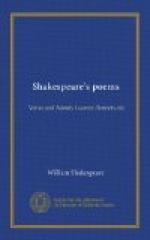
|
| Name: _________________________ | Period: ___________________ |
This test consists of 5 multiple choice questions, 5 short answer questions, and 10 short essay questions.
Multiple Choice Questions
1. In the context of the comparison of Adonis's departure to the departure of a friend onboard ship, which of the following words functions as a pun?
(a) Merciless.
(b) Pitchy.
(c) Fold.
(d) Contend.
2. What colors are emphasized in the description of morning?
(a) Silver and gold.
(b) Yellow and orange.
(c) Red and white.
(d) Blue and green.
3. What technique is used in line 645, "Grew I not faint, and fell I not downright"?
(a) Anadiplosis.
(b) Parallelism.
(c) Antistrophe.
(d) Chiasmus.
4. What technique is used in lines 1123 and 1124, "She looks upon his lips, and they are pale;/ She takes him by the hand, and that is cold"?
(a) Personification.
(b) Symbolism.
(c) Parallelism.
(d) Metonymy.
5. To what does Venus compare the fear of a person in love?
(a) The fear of a mother holding a newborn during a rising flood.
(b) The fear of a shepherd seeing his flock beset by wolves.
(c) The fear of a person carrying treasure who is surrounded by thieves.
(d) The fear of a monarch whose castle is besieged by enemies.
Short Answer Questions
1. What techniques are used in lines 1015 and 1016, "“O love!” quoth she, “how much a fool was I,/ To be of such a weak and silly mind"?
2. What is Venus saying when she asks the world "what canst thou boast/ Of things long since, or anything ensuing" (lines 1077 and 1078)?
3. What does Venus say will die with Adonis?
4. What technique is used in lines 647 and 648, "My boding heart pants, beats, and takes no rest,/ But like an earthquake, shakes thee on my breast"?
5. Which techniques are used in line 838, "love is wise in folly foolish witty"?
Short Essay Questions
1. How does Venus's attitude toward death change when she believes that Adonis is alive?
2. Explain the pun in lines 827 and 828, when after Adonis leaves, the speaker says of Venus, "Even so confounded in the dark she lay,/ Having lost the fair discovery of her way."
3. What does Venus suggest Adonis do if he insists on hunting on the following day?
4. What does Venus say about death when she thinks that Adonis has died?
5. How does Venus portray Adonis having sex as a kind of selfless action and his choosing chastity as selfishness?
6. How does the construction of line 832, "Passion on passion deeply is redoubled," mimic the sense of what is happening in this passage?
7. How does Venus contrast the behavior of fish and birds with the behavior of the boar?
8. What conclusion does Venus reach about why the boar killed Adonis, and what does this cause her to reflect about her own behavior?
9. After Adonis's death, what does Venus predict about love?
10. What is ironic about the description of the colors around the boar's mouth?
|
This section contains 1,100 words (approx. 4 pages at 300 words per page) |

|




